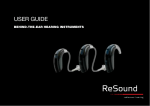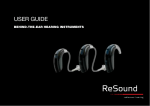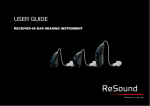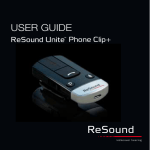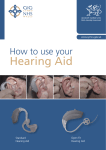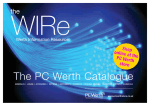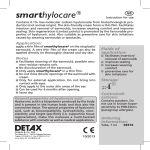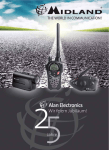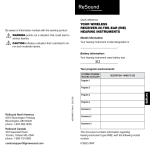Download ReSound AL477/87-DVIW User guide
Transcript
USER GUIDE Behind-the-ear (BTE) Models: Standard Tube Thin Tube Hearing instrument type designations for models included in this user guide are: M70-80, FCC ID: X26M70-80 and M60, FCC ID: X26M60. Please see page 10 for list of models referring to both types. Statement: This device complies with Part 15 of the FCC Rules. Operation is subject to the following two conditions: (1) this device may not cause harmful inter ference, and (2) this device must accept any interference received, including interference that may cause undesired operation. Note: This equipment has been tested and found to comply with the limits for a Class B digital device, pursuant to part 15 of the FCC Rules. These limits are designed to provide reasonable protection against harmful interference in a residential installation. This equipment generates, 2 uses and can radiate radio frequency energy and, if not installed and used in accordance with the instructions, may cause harmful interference to radio communications. However, there is no guarantee that interference will not occur in a particular installation. If this equipment does cause harmful interference to radio or television reception, which can be determined by turning the equipment off and on, the user is encouraged to try to correct the interference by one or more of the following measures: • Reorient or relocate the receiving antenna. • Increase the separation between the equipment and receiver. • Connect the equipment into an outlet on a circuit different from the one in which the receiver is connected. • Consult the dealer or an experienced radio/TV technician for help. Changes or modifications can void the user´s authority to operate the equipment 3 Intended use Generic air-conduction hearing instruments are wearable sound-amplifying devices intended to compensate for impaired hearing. The fundamental operating principle of hearing instruments is to receive, amplify, and transfer sound to the ear drum of a hearing impaired person. List of countries: Products without wireless functionality are intended for worldwide sales. Products with wireless functionality are intended for sale in countries within the European Economic Area as well as Switzerland. The products are in compliance with the following regulatory requirements: • In EU: the device conforms to the Essential Requirements according to Annex I of Council Directive 93/42/EEC for medical devices (MDD) and essential requirements and other relevant provisions of Directive 1999/5/EC (R&TTE). The declaration of conformity may be consulted at www.resound.com • In US: FCC CFR 47 Part 15, subpart C, section 15.249. • Other identified applicable international regulatory requirements in countries outside the EU and US. Please refer to local country requirements for these areas. • Products are categorized as class 2 receivers according to EN 300 440 Specification of restrictions: You are not allowed to operate the equipment within 20 km of the centre of Ny Ålesund, Norway. 4 5 Introduction Congratulations on the purchase of your new hearing instruments. ReSound’s innovative sound technology and design, combined with the customized programming selected by your hearing care professional, will make hearing a more enjoyable experience. Hearing instruments will enable you to hear sounds that you may not have heard in years because of your hearing loss. Practice and a positive attitude are important in learning to use hearing instruments. Your ReSound instruments have been adjusted according to your individual hearing loss and needs. Some people adjust quickly to wearing hearing instruments in their ears and hearing new sounds; other people may need more time. Please read this manual carefully in order to wholly benefit from the use of your hearing instruments. With proper care, maintenance, and usage, your hearing instruments will aid you in better communication for many years. Ask your hearing care professional if you have any questions. Hearing instrument model: Battery size: Tube type: Left serial number: Dome size: Right serial number: ReSound is a registred trade mark of GN ReSound A/S 6 7 Contents Statement . . . . . . . . . . . . . . . . . . . . . . . . . 2 Intended use . . . . . . . . . . . . . . . . . . . . . . 4 List of countries . . . . . . . . . . . . . . . . . . . . . 4 Introduction . . . . . . . . . . . . . . . . . . . . . . . . 6 Description of the hearing instruments . . . 10 Getting started . . . . . . . . . . . . . . . . . . . . 12 On/Off function . . . . . . . . . . . . . . . . . . . . 12 SmartStart . . . . . . . . . . . . . . . . . . . . . . . 12 Inserting/Replacing the battery . . . . . . . . 13 Low battery indicator . . . . . . . . . . . . . . . . 14 Sports lock . . . . . . . . . . . . . . . . . . . . . . 15 8 Inserting/removing hearing instruments . . Operation of the hearing instrument . . . . . Volume control (optional) . . . . . . . . . . . . . Programme button (optional) . . . . . . . . . . Flight mode . . . . . . . . . . . . . . . . . . . . . . . Telephone use . . . . . . . . . . . . . . . . . . . . Listen to radio or TV . . . . . . . . . . . . . . . . Cellular phones . . . . . . . . . . . . . . . . . . . PhoneNow . . . . . . . . . . . . . . . . . . . . . . . Telecoil (optional) . . . . . . . . . . . . . . . . . . . Tele-loop systems . . . . . . . . . . . . . . . . . . 16 20 20 21 23 24 25 25 26 29 29 Direct audio input (optional) . . . . . . . . . . . Connecting/Disconnecting audio boots . . Care and maintenance . . . . . . . . . . . . . . Daily maintenance . . . . . . . . . . . . . . . . . . Cleaning earmoulds . . . . . . . . . . . . . . . . Cleaning thin tubes and domes . . . . . . . . How to apply domes . . . . . . . . . . . . . . . . ReSound Standard domes . . . . . . . . . . . ReSound Tulip domes . . . . . . . . . . . . . . General precautions . . . . . . . . . . . . . . . . General warnings . . . . . . . . . . . . . . . . . . 30 30 32 33 33 34 35 35 36 37 38 Battery warning Information . . . . . . . . . . . Troubleshooting guide . . . . . . . . . . . . . . . Technical Data . . . . . . . . . . . . . . . . . . . . Warranty and repairs . . . . . . . . . . . . . . . . Temperature test, transport and storage information . . . . . . . . . . . . . . . . . 41 42 50 52 53 9 Hearing instruments of type M70-80 are available in the following variants: AL 987-DVIW AL 977-DVIW Open - AL 977-DVIW AL 787-DVIW AL 777-DVIW Open - AL 777-DVIW AL 587-DVIW AL 577-DVIW Open - AL 577-DVIW AL 487-DVIW AL 477-DVIW Open - AL 477-DVIW ALT 987-DVIW ALT 977-DVIW Open - ALT 977-DVIW ALT 787-DVIW ALT 777-DVIW Open - ALT 777-DVIW ALT 587-DVIW 10 ALT 577-DVIW Open - ALT 577-DVIW Hearing instruments of type M60 are available in the following variants: AL 967-DIW Open - AL 967-DIW AL 767-DIW Open - AL 767-DIW AL 567-DIW Open - AL 567-DIW AL 467-DIW Open - AL 467-DIW ALT 967-DIW Open - ALT 967-DIW ALT 767-DIW Open - ALT 767-DIW 1. 2. 3. 4. 5. 6. 7. 8. 9. 10. 11. 12. 13. Programme button Battery compartment & On/Off switch Sound outlet Front microphone inlet Back microphone inlet Volume control (optional) Direct audio input Left/Rightindicator (Left=Blue/Right=Red) Battery lock (optional) Model Manufacturer Serial number Sports lock 5 4 1 12 10 7 11 6 3 8/9 8/9 13 2 11 Getting started On/Off function 1. When the battery door is closed, the hearing instrument turns on, and the default program will be activated. On turn on by several seconds after the battery compartment is closed. With SmartStart, a beep will be heard for each second of the delay period. Off 2. To turn off the hearing instrument, open the battery door. Many individuals can use their fingernail to pull it open. Tip: Whenever the hearing instruments are not in use, remember to turn them off to avoid unnecessary battery consumption. SmartStart Hearing instruments can be turned on once you have placed them on your ears. If you prefer to turn them on just prior to placing them on your ear, your hearing care professional can activate a function called SmartStart. This function will delay the time in which the hearing instruments 12 Inserting/Replacing the battery 3. Open the battery door completely by using your fingernail. 4. Remove the used battery if present. Insert the new battery with the positive side in the correct position. 5. Always use new Zinc-Air batteries that have a minimum remaining shelf life of 1 year. 6. Gently close the battery door. Tip: Remove the batteries to prevent battery leakage or corrosion when the hearing instruments are not in use for an extended period of time. 13 Low battery indicator Your hearing care professional can activate a low battery indicator in your hearing instruments. The hearing instrument will reduce amplification and play a melody if battery power gets too low. This signal will recur every five minutes until the hearing instrument automatically switches off. The timing of the low battery indicator can vary slightly, depending on the type of battery used. It is recommended that you keep spare batteries on hand. two sets of descending tones. After this, your hearing instrument and ReSound Unite Remote Control will continue to work as usual, but you will not be able to use your ReSound Unite TV and Phone Clip. At some point the battery level will also be too low to support the remote control as well and you will once again hear the descending tones. The hearing instruments will continue to work as usual. Once a new battery is inserted, full operation of the accessories will resume. Low battery indicator (instruments paired with accessories only) Active usage of the ReSound Unite accessories (Remote Control, Phone Clip and Unite TV) requires more battery power from the hearing instruments than when they are working without accessories which means that battery life is highly dependent on the amount of wireless accessory usage. When the battery in the hearing instrument has depleted to a level at which use of the ReSound Unite TV and Phone Clip cannot be supported, the hearing instrument will play Sports lock The Sports lock will be applied or adjusted by your hearing care professional. 14 15 Inserting/Removing hearing instruments Insertion (custom earmoulds) 1. Hold the earmould between your thumb and index finger and position its sound outlet in your ear canal. 2. Slide the earmould all the way into your ear with a gentle, twisting movement. 3. Turn the top part of the earmould gently backwards and forwards so that it tucks behind the fold of skin above your ear canal. 4. Move the earmould up and down and gently press to ensure it is positioned correctly in the ear. Opening and closing your mouth can ease insertion. By experimenting, an easier method may be discovered. With proper insertion, hearing instruments should fit snugly but comfortably. If the hearing instruments cause irritation of the ears, contact your hearing care professional. Note: Never attempt to modify the shape of the hearing instrument, earmoulds, or tubing yourself. Tip: It may be helpful to pull your ear up and outward with your opposite hand during insertion. 5. Make sure the hearing instrument is seated behind the ear. 16 17 Insertion (domes/custom earmoulds with thin tubes) 1. Hold the thin tube where it bends, and gently push the dome into the ear canal. Push the dome far enough into the ear canal so that the thin tube lies flush with the head. 2. It is important that the tube and the dome fit correctly into your ear. 3. When the dome is place correctly, you should not be able to see the thin tube sticking out when facing a mirror. Note: You should never attempt to bend or modify the shape of the thin tube. Removal (custom earmolds) 1. Hold a portion of your earmould towards the back of the ear. 2. Pull the earmould outward and simultaneously rotate the earmould forward. 3. Consult your hearing care professional if you have difficulties removing the hearing instrument. Removal (domes/custom earmoulds with thin tubes) 1. Hold the thin tube with your thumb and forefinger and pull the tube outward. 2. For thin tube custom earmoulds, grasp the removal string and pull the earmould outward. 3. Consult your hearing care professional if you have difficulties removing the hearing instrument. 18 19 Operation of the hearing instrument Volume control (optional) The volume control will allow the volume of hearing instruments to be increased or decreased. 1. To increase the volume, push the volume control up. 2. To decrease the volume, push the volume control down. When volume is increased or decreased, a beep signal will be heard for each incremental change. When the upper or lower limits of the volume range are reached, a beep signal with a longer duration will be heard. 20 Programme button Depending on your experience level with hearing instruments, individual hearing needs, and the type of listening environments you experience, your hearing care professional may activate additional programmes. If additional programmes have been activated, the following list explains how they work. 1. You can switch between programmes by pushing the push button once. 2. You will then hear one or more beeps. The number of beeps indicates which programme you have selected (one beep = programme one, two beeps = programme two, etc.). 3. When the hearing instruments are turned off and then back on, the hearing instrument always returns to the default setting (programme one). 21 Programme 1 2 3 4 Description of when to use Flight mode* When boarding a flight wireless functionality must be deactivated, as it is not allowed to radiate radio signals during flights. It is possible to disable wireless operation by opening and closing the battery compartment of the hearing instrument while at the same time pressing the push button. When disabled manually, wireless operation may be re-enabled by opening and closing the battery compartment normally, (i.e. without at the same time pressing the push button). *Instruments paired with ReSound Unite accessories only 22 23 Telephone use Finding the optimal position for holding a telephone may require practice for some individuals, and one or more of the following suggestions may be helpful. 1. Hold the telephone as you would normally. 2. Hold the telephone towards the top of the ear (closer to where the microphones are). 3. If whistling occurs, it may take a few seconds of holding the telephone in the same position before the hearing instrument eliminates the feedback. 4. Any whistling may also be decreased by holding the telephone slightly away from the ear. 5. Depending on your individual needs, your hearing care professional may activate a programme specifically for telephone use. 24 Listen to radio or TV When listening to the TV or the radio, start out by listening to news commentators since they usually speak clearly, then try other programmes. If you find it difficult to listen to TV or radio, your hearing care professional will be able to give you advice on available accessories to enhance your listening capabilities for TV and radio. Cellular phones Your hearing instrument is designed to comply with the most stringent Standards of International Electromagnetic Compatibility. However, not all cell phones are hearing instrument compatible. The varying degree of disturbance can be due to the nature of your particular cellular phone or of your wireless telephone service provider. If you find it difficult to obtain a good result while using your cellular phone, your hearing care professional will be able to give you advice on available accessories to enhance listening capabilities. 25 PhoneNow The PhoneNow function, allows your hearing instrument to automatically switch to your tele phone programme when a telephone receiver is raised to the ear. When the telephone receiver is removed from the ear, the hearing instrument automatically returns to the previous listening programme. Placement of PhoneNow magnets In order to place PhoneNow magnets properly: 1. Clean the telephone receiver thoroughly. 2. Hold the telephone vertically, in a position similar to when making a telephone call. 3. Place the magnets just below the telephone receiver. If necessary, move the magnet to another position to improve ease of use and comfort while speaking. 26 4. Only use a recommended cleaning agent to clean the telephone prior to placing the magnet on the phone. PhoneNow usage Telephones can be used in a normal manner. A short melody will indicate that the PhoneNow feature has automatically switched the hearing instrument to your telephone programme. Initially, you may need to move the telephone receiver slightly to find the best position for reliable PhoneNow activation and good hearing on the telephone. PhoneNow precautions 1. Keep magnets out of reach of pets, children and people with mental disabilities. If a magnet is swallowed, please seek advice from a medical practitioner. 27 2. The magnet used to strengthen the magnetic field of a telephone receiver may affect functionality of some medical devices or electronic systems. Always keep the magnet or a telephone equipped with the magnet at least 30 cm (12”) away from pacemakers, credit cards and other magnetically sensitive devices. 3. High distortion during dialing or phoning may mean that the magnet is not in the optimal position relative to the telephone receiver. To avoid the issue, please move the magnet to another place on the telephone receiver. 4. Only use magnets supplied by GN ReSound. 28 Telecoil (optional) If equipped, a telecoil can be activated by your hearing care professional and accessed through one of the additional programmes. A telecoil picks up a telephone’s magnetic signal and converts it to sound. An optional telephone programme may help to improve speech understanding on the telephone. When using a telecoil programme, the receiver of the telephone may need to be held closer to the hearing instrument. The handset of the telephone may need to be moved to slightly different positions in order to find the best reception. Tele-loop systems Many places, such as theatres, houses of worship, and schools are equipped with tele-loop systems. When using a telecoil programme with tele-loop systems, sound is picked up directly and may improve speech understanding. If there is no sound from the hearing instruments in a tele-loop system and with a telecoil programme activated, the tele-loop system may not be turned on or is not operating correctly. If a facility is not equipped with a tele-loop system, sitting as close as possible to the front may be helpful. 29 Direct audio input (optional) Use of direct audio input (DAI), which enables a direct connection of the hearing instruments to items such as television, radio, and remote microphones, may increase speech understanding for some individuals. The sound source is connected to the hearing instruments by a cable or a wireless FM system to the audio boot. This accessory connects to the bottom of the hearing instruments, and once properly clicked into place, the hearing instruments switch to DAI automatically. Connecting/Disconnecting audio boots Connecting audio boots 1 1. Align the tip of the audio boot with the groove just above the battery compartment and below the model number. 30 2. Once in place, move the boot in the direction of the battery compartment. 2 3. Gently click the audio boot onto the hearing instrument. Disconnecting audio boots 4. Press and hold the button on the front side of the audio boot. 5. Gently remove the audio boot from the hearing instrument. 3 4 5 31 Care and maintenance Proper handling Your hearing instrument is protected by a layer of protective, hydrophobic nanocoat material. However, please follow these instructions to further prolong the durability of your hearing instruments. 1. Never immerse hearing instruments in water or other liquids, as liquids may cause permanent damage to the hearing instruments. 2. Avoid rough handling of hearing instruments or dropping them on hard surfaces or floors. 3. Do not leave hearing instruments in or near direct heat or sunlight, as excessive heat can cause damage or deform the casing. 4. Hair spray, make-up, etc. may damage hearing instruments. Remove the instruments prior to the application of cosmetics. 32 Daily maintenance It is important to keep your hearing instrument clean and dry. On a daily basis, clean the hearing instruments using a soft cloth or tissue. In order to avoid damage due to humidity or excessive perspiration, the use of a drying kit is recommended. Cleaning earmoulds 1. Remove the earmould and attached tubing from the hearing instruments prior to cleaning. 2. Clean the earmould using a mild soap, and rinse with lukewarm water. 3. After cleaning, dry earmoulds thoroughly and remove any residual water and debris from the tubing utilising an air bulb and wire loop. 33 Note: Earmould tubing may become stiff, brittle, or discoloured over time. Contact your hearing care professional regarding tube changes. Cleaning thin tubes and domes 1. Remove thin tubes from hearing instruments before cleaning by unscrewing them counter clockwise. 2. Wipe down thin tubes and domes with a damp cloth. 3. In order to clear the thin tube of moisture and debris, push the black cleaning rod through the thin tube, beginning at the end opposite the dome. 34 Note: Thin tube and dome systems should be changed every three months or sooner, should the components become stiff or brittle. How to apply domes It is recommended that your hearing care professional change domes, as incorrect dome replacement could result in the dome falling out in the ear. ReSound Standard domes 1. Push the new dome over the flanges on the thin tube. 1 2 2. Make sure that the new dome is properly and securely mounted. 35 ReSound Tulip domes Tulip domes are mounted in a similar manner to standard domes, but a few extra steps are required. Tulip domes consist of two “petals”. It is important to note that the largest petal is the outermost petal. To ensure this: 1. Push the largest petal away from the thin tube using a finger. This bends the petal forward. 2. Then push the largest petal back, and it will be placed on top of the smaller petal. General precautions 1. Do not leave hearing instruments in the sun, near an open fire, or in a hot, parked car. 2. Do not wear hearing instruments while showering, swimming, in heavy rain, or in a moist atmosphere such as a steam bath or sauna. 3. Should the hearing instrument become moist, remove the battery and place the hearing instrument in a closed container with a drying agent. Your hearing care professional can provide options for drying containers or kits. 4. Remove the hearing instruments when applying items such as cosmetics, perfume, aftershave, hair spray, and suntan lotion. 5. When wireless function is activated, the device uses low-powered digitally coded transmissions in order to communicate with other wireless devices. Although unlikely, nearby electronic devices may be affected. In that case, move the hearing instrument away from the affected electronic device. 36 37 6. When using wireless functionality and the devices are affected by electromagnetic interference, move away from the source. General warnings 1. Consult a hearing care professional if you think there may be a foreign object in your ear canal, if you experience skin irritation, or if excessive ear wax accumulates with the use of the hearing instrument. 2. Different types of radiation, from e.g. NMR, MRI, or CT scanners, may damage hearing instruments. It is recommended not to wear hearing instruments during these or other similar procedures. Other types of radiation, such as burglar alarms, room surveillance systems, radio equipment, mobile telephones, contain less energy and will not damage hearing instruments. However, they have the potential to momentarily affect the sound quality or temporarily create strange sounds from hearing instruments. 38 3. Do not wear hearing instruments in mines, oil fields, or other explosive areas unless those areas are certified for hearing instrument use. 4. Do not allow others to use your hearing instruments. This may cause damage to the hearing instruments or to the hearing of the other individual. 5. Due to choking hazards, hearing instrument usage by children or individuals who are mentally challenged should be supervised at all times. 6. Hearing instruments should be used only as prescribed by your hearing care professional. Incorrect use may result in hearing loss. 7. Warning to hearing care professionals: Special care should be exercised in selecting and fitting hearing instruments with maximum sound pressure level that exceeds 132dB SPL with an IEC 60711:1981 occluded ear simulator. There may be a risk of impairment of the remaining hearing. 8. Be careful when boarding flights to deactivate the wireless functionality. 39 9. Keep magnets out of reach of pets, children and people with mental disabilities. If a magnet is swallowed, please seek advice from a medical practitioner. 10.Turn off your wireless functionality by using the flight mode in areas where radio frequency emission is prohibited. 11.Only connect ReSound hearing instruments to ReSound accessories intended and qualified to be used with ReSound hearing instruments. 12.For use of wireless functionality only use ReSound Unite accessories. For further guidance please refer to the user guide of the relevant ReSound Unite accessory. 40 Battery warning information Batteries, although very small, contain dangerous substances, and should be disposed of carefully. This is for the safety of you and the environment. Please note: 1. DO NOT attempt to recharge standard zinc air batteries. They may leak or explode. 2. DO NOT attempt to dispose of batteries by burning them. 3. DO NOT place batteries in your mouth. Consult a physician immediately if a battery has been swallowed, as they can be harmful to your health. 4. Keep batteries away from pets, children and individuals who are mentallly challenged. 41 Troubleshooting Guide SYMPTOM No sound 42 CAUSE POSSIBLE REMEDY • Not turned on • Turn on by closing the battery door • Dead battery • Replace battery • Battery door will not close • Insert battery properly • Blocked earmould or tube • Clean earmould or tube • Blocked wax filter • Replace wax filter or consult your hearing care professional 43 Troubleshooting Guide SYMPTOM Not loud enough 44 CAUSE POSSIBLE REMEDY • Incorrect earmould placement • Reinsert earmould • Blocked earmould or dome • Clean earmould, replace dome, replace filter • Blocked sound outlet filter • Change filter or consult your hearing care professional • Change in hearing sensitivity • Consult your hearing care professional • Excessive ear wax • Consult your physician • Volume set too low • Increase the volume control if available or consult your hearing care professional 45 Troubleshooting Guide SYMPTOM Excessive whistling / feedback 46 CAUSE POSSIBLE REMEDY • Incorrect earmould placement • Re-insert earmould carefully • Incorrect dome placement • Re-insert dome • Excessive ear wax • Consult your hearing care professional • Feedback control may need adjustment • Consult your hearing care professional • Earmould tubing worn or damaged • Consult your hearing care professional • Thin tube connection loose • Change thin tube or consult your hearing care professional • Hearing instrument settings not optimal • Consult your hearing care professional 47 Troubleshooting Guide SYMPTOM Sound distorted / not clear Wireless does not work 48 CAUSE POSSIBLE REMEDY • Weak battery • Replace battery • Improper earmould or dome fit • Consult your hearing care professional • Hearing instrument damaged • Consult your hearing care professional • Hearing instrument settings not optimal • Consult your hearing care professional • Possible Root Cause - Device is in flight mode • For devices with push button: Open and close the battery compartment. For devices without push button: Open and close the battery door twice within 10 seconds (if Root Cause is device in flight mode) If there are any other problems not mentioned in this guide, please contact your hearing care professional. 49 Technical Data Hearing Instrument Model Technical Data Maximum output (2ccCoupler / IEC 60118-7) Models AL977/87-DVIW, AL777/87-DVIW, AL577/87-DVIW, AL477/87-DVIW, AL967-DIW, AL767-DIW, AL567-DIW, AL467-DIW are available in following variants: Standard tube 50 AL967-DIW, AL767-DIW, AL567-DIW, AL467-DIW, ALT967-DIW, ALT767-DIW (Open) 119 dB SPL (typical) AL977-DVIW, AL777-DVIW, AL577-DVIW, AL477-DVIW, ALT977-DVIW, ALT777-DVIW, ALT577-DVIW (Open) 123 dB SPL (typical) Hearing Instrument Model Maximum output (2ccCoupler / IEC 60118-7) AL967-DIW, AL767-DIW, AL567-DIW, AL467-DIW, ALT967-DIW, ALT767-DIW 123 dB SPL (typical) AL977-DVIW, AL777-DVIW, AL577-DVIW, AL477-DVIW, ALT977-DVIW, ALT777-DVIW, ALT577-DVIW 127 dB SPL (typical) AL987-DVIW, AL787-DVIW, AL587-DVIW, AL487-DVIW, ALT987-DVIW, ALT787-DVIW, ALT587-DVIW 130 dB SPL (typical) 51 Warranty and repairs ReSound provides a warranty on hearing instruments in the event of defects in workmanship or materials, as described in applicable warranty documentation. In its service policy, ReSound pledges to secure functionality at least equivalent to the original hearing instrument. As a signatory to the United Nations Global Compact initiative, ReSound is committed to doing this in line with environment-friendly best practices. Hearing instruments therefore, at ReSound’s discretion, may be replaced by new products or products manufactured from new or serviceable used parts, or repaired using new or refurbished replacement parts. The warranty period of hearing instruments is designated on your warranty card, which is provided by your hearing care professional. 52 For hearing instruments that require service, please contact your hearing care professional for assistance. ReSound hearing instruments that malfunction must be repaired by a qualified technician. Do not attempt to open the case of hearing instruments, as this will invalidate the warranty. Temperature test, transport and storage information GN ReSound Hearing Instruments are subjected to various tests in temperature and damp heating cycling between -25 C and +70C according to internal and industry standards. During transport or storage, the temperature should not exceed the limit values of -20C to 60C and relative humidity of 90% RH, non condensing (for limited time). The air pressure between 500 and 1100 hPa is appropriate. 53 Be aware of information marked with the warning symbol WARNING points out a situation that could lead to serious injuries, CAUTION indicates a situation that could lead to minor and moderate injuries. Advice and tips on how to handle your hearing instrument better. Equipment includes RF transmitter. Product is a Type B applied part. Please ask your local hearing care professional concerning disposal of your hearing instrument United Kingdom GN ReSound Ltd. Kirtlington Business Centre Portway Kirtlington Oxon OX5 3JA Tel.: +44 1869 352 800 Fax: +44 1869 343 466 www.gnresound.co.uk Australia GN ReSound Pty. Ltd. Unit R1 Regents Park Estate 391 Park Road Regents Park NSW 2143 Tel.: (free) 1800 658 955 Fax: +61 2 9743 7472 www.gnresound.com.au Any issues relating to the EU Medical Device Directive 93/42/EEC, or Council Directive 1999/5/EC on Radio Equipment and Telecommunications terminal equipment should be directed to ReSound A/S New Zealand GN ReSound (NZ) Ltd. 12 Parkway Drive Mairangi Bay Auckland Tel.: (free) 0800 900 126 Fax: (free) 0800 007 695 www.gnresound.co.nz 17483300-GB-11.08 Rev. F Worldwide Headquarters ReSound A/S Lautrupbjerg 7 DK-2750 Ballerup, Denmark Tel.: +45 45 75 11 11 Fax: +45 45 75 11 19 www.resound.com





























